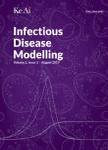Impact of climate change on dengue fever epidemics in South and Southeast Asian settings:A modelling study
作者机构:Jockey Club School of Public Health and Primary CareThe Chinese University of Hong KongHong Kong Special Administrative RegionChina Centre for Health Systems and Policy ResearchThe Chinese University of Hong KongHong Kong Special Administrative RegionChina Clinical Trials and Biostatistics LaboratoryShenzhen Research InstituteThe Chinese University of Hong KongShenzhenChina Division of Landscape ArchitectureDepartment of ArchitectureFaculty of ArchitectureThe University of Hong KongHong Kong Special Administrative RegionChina School of Public HealthShanghai Jiao Tong University School of MedicineShanghaiChina School of Global HealthChinese Center for Tropical Diseases ResearchShanghai Jiao Tong University School of MedicineShanghaiChina
出 版 物:《Infectious Disease Modelling》 (传染病建模(英文))
年 卷 期:2023年第8卷第3期
页 面:645-655页
核心收录:
学科分类:1004[医学-公共卫生与预防医学(可授医学、理学学位)] 100401[医学-流行病与卫生统计学] 10[医学]
基 金:supported by the National Natural Science Foundation of China(grant numbers 71974165) partially supported by Health and Medical Research Fund(grant numbers INF-CUHK-1)
主 题:Temperature Rainfall Extreme weather event Dengue fever
摘 要:The potential for dengue fever epidemic due to climate change remains uncertain in tropical *** study aims to assess the impact of climate change on dengue fever transmission in four South and Southeast Asian *** collected weekly data of dengue fever incidence,daily mean temperature and rainfall from 2012 to 2020 in Singapore,Colombo,Selangor,and Chiang *** for temperature and rainfall were drawn for three Shared Socioeconomic Pathways(SSP126,SSP245,and SSP585)*** a disease transmission model,we projected the dengue fever epidemics until 2090s and determined the changes in annual peak incidence,peak time,epidemic size,and outbreak duration.A total of 684,639 dengue fever cases were reported in the four locations between 2012 and *** projected change in dengue fever transmission would be most significant under the SSP585 *** comparison to the 2030s,the peak incidence would rise by 1.29 times in Singapore,2.25 times in Colombo,1.36 times in Selangor,and10 times in Chiang Mai in the 2090s under ***,the peak time was projected to be earlier in Singapore,Colombo,and Selangor,but be later in Chiang Mai under the SSP585 *** in a milder emission scenario of SSP126,the epidemic size was projected to increase by 5.94%,10.81%,12.95%,and 69.60%from the 2030se2090s in Singapore,Colombo,Selangor,and Chiang Mai,*** outbreak durations in the four settings were projected to be prolonged over this century under SSP126 and SSP245,while a slight decrease is expected in 2090s under *** results indicate that climate change is expected to increase the risk of dengue fever transmission in tropical areas of South and Southeast *** greenhouse gas emissions could be crucial in reducing the transmission of dengue fever in the future.



